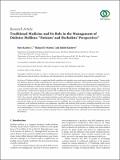| dc.description.abstract | Background. Diabetes mellitus is a complicated health condition with multiple causes and many treatment options. Various myths
may infuence diabetics’ health-seeking behavior, and they may use traditional medicines, which include normal foods and herbs,
for primary health care. Te aim of this study was to determine patients’ and herbalists’ practices and perspectives regarding the use
of traditional medicines and the role of traditional medicines in the management of diabetes. Methods and Findings. We conducted
a cross-sectional study with a mixed-methods design. We interviewed 140 patients attending diabetic clinics using a structured
questionnaire, conducted focus group discussions with an additional 20 diabetic patients, and conducted in-depth interviews with
8 local herbalists. Te majority of the diabetic participants believed that diabetes is caused by a high-carbohydrate diet. Of the
140 participants who answered the questionnaire, 67.2% reported using traditional medicines to manage their diabetes, including
58.6% who reported using both conventional medicines and traditional medicines. Some participants believed that combining
conventional and traditional medicines improved the efectiveness of treatment. Reasons given for using traditional medicines
included the high cost of conventional treatment and the availability and accessibility of the traditional medicines. Te most
commonly used traditional medicines were indigenous vegetables and medicinal plant products including amalanth leaves, hare
lettuce leaves, nightshade leaves, spider plant leaves, okra pods, moringa leaves and seeds, soursop leaves, black plum back, avocado
seed, and lemongrass. Conclusion. Patients and herbalists provided a range of perspectives regarding the use of traditional medicines
to treat diabetes. Further research is needed to identify bioactive compounds present in commonly used traditional medicines and
their efcacy. | en_US |

